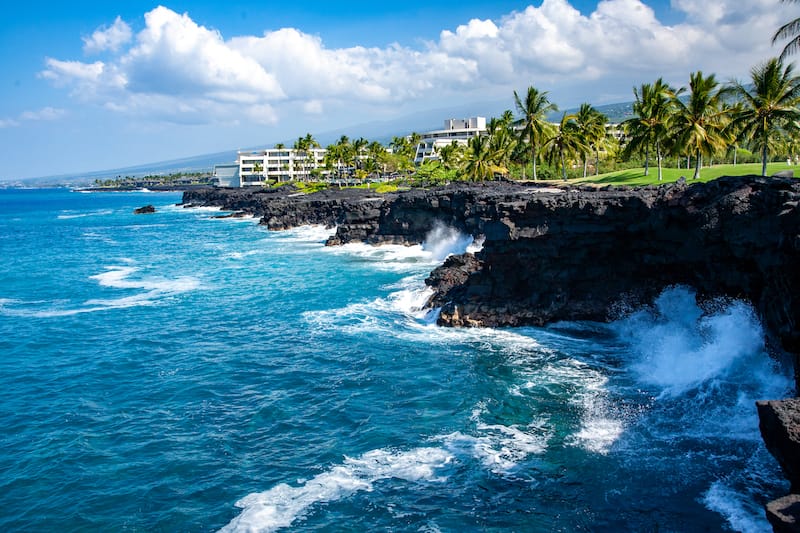Kona Island Geography and Environment

Kona Island, nestled within the Hawaiian archipelago, boasts a captivating landscape shaped by volcanic forces and a diverse array of ecosystems. This island, like its fellow Hawaiian islands, owes its existence to the fiery activity of the Pacific Ocean’s “hot spot.”
Volcanic Origins and Unique Landscape
Kona Island’s geological history is a testament to the power of volcanic eruptions. The island’s foundation is a shield volcano, a type of volcano characterized by its broad, gently sloping form. Over millennia, numerous eruptions have contributed to its growth, leaving behind distinct features that define its landscape. The Kohala Volcano, located in the northern part of the island, is the oldest and most eroded of the five volcanoes that formed Kona Island. It stands as a reminder of the island’s volcanic past.
The island’s unique landscape is a result of its volcanic origins. Vast lava flows have sculpted its surface, creating expansive plains, rugged cliffs, and deep canyons. The presence of volcanic ash and fertile soils supports a rich diversity of plant life. Kona Island’s landscape is a tapestry of contrasting textures and colors, a visual testament to its fiery origins.
Diverse Ecosystems
Kona Island is home to a remarkable variety of ecosystems, each adapted to its unique environment. The island’s diverse landscapes, ranging from rainforests to coastal areas, provide habitats for a wide array of flora and fauna.
- Rainforests: The windward slopes of Kona Island receive abundant rainfall, creating lush rainforests. These forests are characterized by towering trees, thick undergrowth, and a high level of biodiversity. They are home to a variety of endemic species, including the Hawaiian Monk Seal and the endangered Hawaiian Hawk.
- Coastal Areas: The coastline of Kona Island is a vibrant ecosystem, where the ocean meets the land. Coral reefs, seagrass meadows, and sandy beaches provide habitats for a multitude of marine life. These areas are also important nesting grounds for sea turtles and migratory birds.
- Volcanic Slopes: The volcanic slopes of Kona Island are home to a variety of ecosystems, from dry grasslands to scrublands. These areas are characterized by their unique volcanic soils, which support a variety of drought-tolerant plants and animals.
Impact of Climate Change
Climate change poses a significant threat to the environment of Kona Island. Rising temperatures, changing rainfall patterns, and rising sea levels are impacting the island’s ecosystems and the communities that rely on them.
- Rainfall Patterns: Climate change is altering rainfall patterns on Kona Island, leading to more frequent droughts and periods of intense rainfall. These changes can impact water resources, agriculture, and the health of ecosystems.
- Temperature: Rising temperatures are affecting the island’s ecosystems, leading to changes in plant and animal distributions. For example, coral reefs are particularly vulnerable to rising ocean temperatures, which can cause coral bleaching and death.
- Sea Level: Rising sea levels are threatening coastal areas, leading to erosion, flooding, and saltwater intrusion into freshwater sources. These changes can displace coastal communities and damage critical infrastructure.
Kona Island Culture and History

Kona Island’s cultural tapestry is rich and vibrant, woven from the threads of its indigenous Hawaiian heritage and the influences of European settlers. The island’s history is a testament to the resilience of its people and the enduring spirit of its traditions.
Indigenous Hawaiian Culture
The arrival of the first Polynesians to Kona Island, believed to be around the 13th century, marked the beginning of a unique and thriving culture. These early settlers, known as the “Kanaka Maoli” or “Native Hawaiians,” adapted to the island’s diverse environment, developing sophisticated systems of agriculture, fishing, and navigation. They established a complex social structure based on kinship and respect for the land, known as “kapu” – a system of sacred laws that governed all aspects of life.
- Spiritual Beliefs: The ancient Hawaiians held deep reverence for the natural world, believing that gods and goddesses inhabited mountains, volcanoes, and the ocean. They practiced a form of animism, attributing spiritual significance to natural phenomena and objects. Their spiritual beliefs were deeply intertwined with their daily lives, influencing everything from farming practices to social interactions.
- Traditional Arts and Crafts: The indigenous Hawaiians were skilled artisans, creating beautiful objects from natural materials. Weaving, carving, and music were integral parts of their cultural expression. They crafted intricate tapa cloth from the bark of the paper mulberry tree, carved intricate figures from wood, and played traditional instruments like the ukulele and the ipu (gourd). These art forms not only served practical purposes but also held deep symbolic meaning, conveying stories and values across generations.
- Language and Oral Traditions: The Hawaiian language, a melodious and expressive tongue, was the primary means of communication and storytelling. Oral traditions played a crucial role in preserving history, knowledge, and cultural values. Stories, songs, and chants were passed down through generations, ensuring the continuity of their cultural heritage.
The Arrival of European Settlers
The arrival of European settlers in the 18th century marked a significant turning point in Kona Island’s history. Captain James Cook, a British explorer, landed on the island in 1778, initiating a period of contact and exchange that would profoundly impact the indigenous Hawaiian culture. The introduction of new diseases, the disruption of traditional land ownership, and the establishment of a new political order brought about profound changes.
Coffee’s Role in Kona Island’s Economy and Culture
Coffee cultivation, introduced in the 19th century, became a cornerstone of Kona Island’s economy and culture. The fertile volcanic soils and the island’s unique microclimate provided ideal conditions for growing high-quality coffee beans. Kona coffee gained international acclaim for its distinctive flavor and aroma, becoming a symbol of the island’s prosperity and a source of pride for its residents.
- Economic Impact: The coffee industry has been a significant contributor to Kona Island’s economy, providing employment opportunities and generating revenue for local businesses. The cultivation and processing of coffee have become integral parts of the island’s livelihood, supporting farmers, roasters, and retailers.
- Cultural Significance: Coffee has become deeply embedded in Kona Island’s culture. From the annual Kona Coffee Cultural Festival to the numerous coffee farms that offer tours and tastings, coffee is an integral part of the island’s identity. The rich history and traditions surrounding coffee cultivation have fostered a sense of community and pride among Kona’s residents.
Kona Island Tourism and Attractions

Kona Island is a paradise for travelers seeking adventure, relaxation, and cultural immersion. With its stunning beaches, lush rainforests, volcanic landscapes, and rich history, Kona Island offers something for everyone. Whether you’re interested in exploring the underwater world, hiking through volcanic craters, or simply soaking up the sun on a pristine beach, Kona Island has it all.
Kona Island Travel Itinerary
A three-day trip to Kona Island allows for a taste of the island’s diverse offerings. Here’s a suggested itinerary:
Day 1: Exploring the Coast and Culture
- Morning: Arrive at Kona International Airport (KOA) and check into your hotel in Kailua-Kona. Explore the historic Kailua Pier, a bustling hub of activity, and enjoy a leisurely walk along the waterfront.
- Afternoon: Visit the Kona Coffee Belt, a region known for its world-renowned coffee. Take a tour of a coffee plantation and learn about the cultivation process. Indulge in a coffee tasting session and savor the rich flavors of Kona coffee.
- Evening: Enjoy a traditional Hawaiian luau, featuring authentic food, music, and dance performances. Immerse yourself in the vibrant culture of the island and witness the captivating storytelling through dance.
Day 2: Adventure in the Ocean and Mountains
- Morning: Embark on a snorkeling or scuba diving excursion to explore the vibrant coral reefs and diverse marine life. Kona Island is renowned for its underwater beauty, with an abundance of colorful fish, turtles, and even manta rays.
- Afternoon: Hike through the lush rainforests of Kealakekua Bay. Admire the cascading waterfalls and panoramic views of the coastline. Explore the historical Pu’uhonua o Honaunau National Historical Park, a place of refuge for those who broke the ancient Hawaiian laws.
- Evening: Enjoy a delicious dinner at a waterfront restaurant and watch the sunset over the Pacific Ocean.
Day 3: Volcanoes and Relaxation
- Morning: Take a day trip to Volcanoes National Park on the Big Island. Witness the awe-inspiring power of nature as you explore the active Kilauea volcano and observe the lava flows. Hike through the volcanic landscape and learn about the geological history of the island.
- Afternoon: Relax on one of Kona Island’s pristine beaches. Choose from the black sand beaches of Punalu’u Black Sand Beach or the white sand beaches of Hapuna Beach State Recreation Area.
- Evening: Indulge in a spa treatment or enjoy a romantic dinner at a fine-dining restaurant. Reflect on your incredible Kona Island experience.
Best Time to Visit Kona Island
The best time to visit Kona Island is during the shoulder seasons, from April to May and September to October. The weather is pleasant, with warm temperatures and moderate rainfall. Crowds are smaller, and prices are typically lower compared to the peak season.
Peak Season (June to August)
During the peak season, the weather is warm and sunny, with minimal rainfall. However, expect larger crowds, higher prices, and limited availability for accommodation and activities.
Shoulder Seasons (April to May and September to October)
The shoulder seasons offer a balance between pleasant weather and manageable crowds. Temperatures are still warm, and rainfall is minimal. This period is ideal for travelers seeking a more affordable and less crowded experience.
Off-Season (November to March)
The off-season brings cooler temperatures and increased rainfall. While prices are generally lower, some activities may be limited due to weather conditions.
Areas of Kona Island
Kona Island is divided into distinct areas, each offering unique attractions, accommodations, and atmospheres.
Kailua-Kona
Kailua-Kona is the main town on Kona Island and a bustling hub of activity. It boasts a vibrant waterfront, historic sites, and a wide range of restaurants, shops, and accommodations. The town is also a great starting point for exploring the island’s attractions.
Keauhou
Keauhou is a resort area located south of Kailua-Kona. It offers luxury accommodations, championship golf courses, and a variety of water sports activities. Keauhou is known for its beautiful beaches and calm waters, making it ideal for families and those seeking relaxation.
Holualoa
Holualoa is a charming village nestled in the hills above Kailua-Kona. It’s known for its art galleries, coffee plantations, and peaceful atmosphere. Holualoa is a great destination for those seeking a slower pace and a taste of local culture.
North Kona
North Kona encompasses the northern part of the island, including the popular resort towns of Waikoloa and Hapuna. This area is renowned for its pristine beaches, world-class resorts, and stunning natural beauty.
South Kona
South Kona is a more rural area known for its rugged volcanic landscape, secluded beaches, and agricultural farms. This region offers a glimpse into the island’s authentic charm and is a great destination for nature lovers and those seeking a peaceful escape.
Kona Island, a volcanic paradise in Hawaii, is known for its stunning beaches, lush rainforests, and active volcanoes. While exploring the island’s natural wonders, you might be considering a return trip to the mainland via Alaska Airlines, which conveniently operates out of JFK Airport.
If you’re planning to fly with Alaska Airlines, it’s helpful to know what terminal is alaska airlines at jfk so you can arrive at the correct gate with ample time to spare. After your flight, you can return to the island’s unique culture and enjoy the world-renowned Kona coffee.
